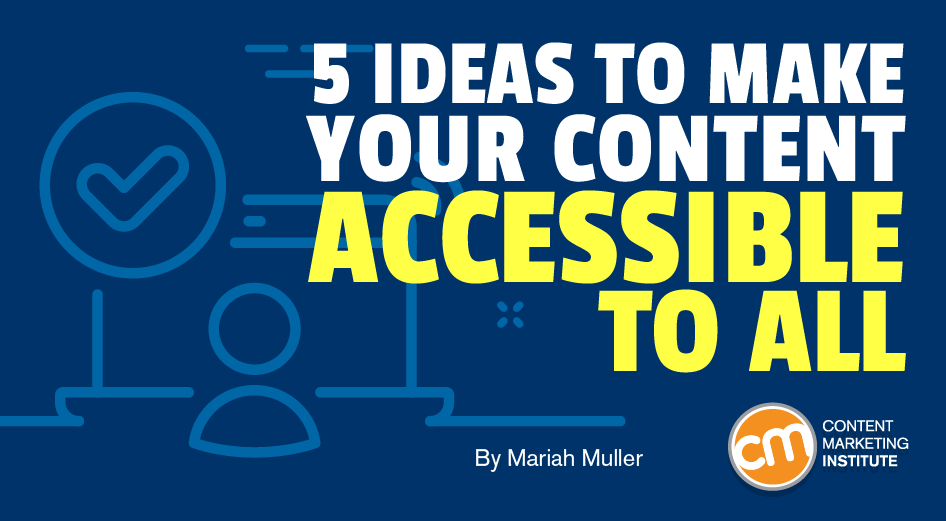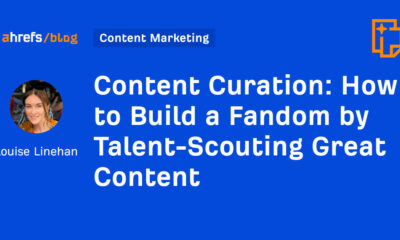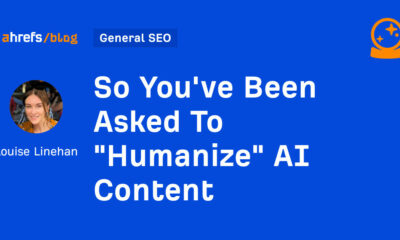MARKETING
5 Ideas To Make Your Content Accessible to All

Making your content accessible to all in your audience is a smart strategy even if the law doesn’t require it of your organization.
Accessible content allows anyone to consume your creations. It also signals to everyone that your brand recognizes the value of inclusive content.
What exactly is accessible content?
According to the W3C Working Group (and illustrated below by Straive), web content accessibility encompasses four principles. It is:
- Perceivable – users can perceive all the information presented even if one of their senses isn’t working.
- Operable – users can operate with the interface components and navigation.
- Understandable – users can understand the information.
- Robust – users can access content through assistive technologies.

Web accessibility also addresses “situational disabilities” – temporary factors that affect how a person accesses or perceives a website or app. For example, a poor Wi-Fi connection could prevent access on a mobile device or bright natural light hampers a user who is outdoors. Or an ear infection could prevent a consumer from hearing adequately.
Thus, the most accessible content is still usable, perceivable, and understandable no matter how, when, or where a person accesses the content.
What content needs to be accessible?
The widely accepted global authority Web Content Accessibility Guidelines (WCAG) defines web content as “the information in a web page or web application, including natural information such as text, images, and sounds, and code or markup that defines structure, presentation, etc.”
In other words, every piece of digitally published content should be accessible, including:
- Text-based content
- PDFs
- E-books
- White papers
- Video – live and recorded
- Audio – live and recorded
- Images and graphics
How can you fix inaccessible content? Here are five opportunities:
1. Use descriptive text
A lack of descriptive text for essential components of a website is a common accessibility barrier.
A lack of descriptive text for essential components of a website is a common #accessibility barrier, says #MariahMuller via @CMIContent. Click To Tweet
In this example, phrases like “read more” and “learn more” are not sufficiently explicit. Instead, label links or buttons with what the person can expect to find, such as “browse campsites” or “read our full mission.”

Luckily, including descriptive page titles, headings, anchor text, and meta descriptions, as well as alt text for images, also is helpful for search engine optimization. That’s because these forms of structured data make accessible to the machines – the search engine crawlers that scroll through your site’s content. Similarly, they provide information for assistive technologies that help people with physical or visual impairments access web content.
2. Use sufficient color contrasts
Low contrast content, such as light grey text on a white background, can make it hard for some people to see and understand the content. It is not only difficult for people with permanent visual impairment, but it’s hard for people to view in bright or natural light and on poorly calibrated screens.
WCAG’s contrast criteria specify minimum contrasts between text and background colors. For font sizes 18 points or larger (14 points if bolded), the contrast should be 3-to-1. For smaller font sizes, the contrast should be 4.5-to-1. (This free contrast tool can help you determine if the color contrast ratio is the proper ratio.)
3. Create alternative formats for audio and visual content
Making videos, webinars, and audio content accessible means including alternative formats, such as transcripts. This text-based content also can be helpful for SEO because it can be searched by crawlers.
Making videos, webinars, and audio content #accessible means including alternative formats, such as transcripts, says #MariahMuller via @CMIContent. Click To Tweet
It also can be helpful to minimize background noises, include descriptive timestamps, and add a skip feature for your audience who might have some sight or hearing capabilities.
4. Manifest a good user experience
Remember, digital accessibility isn’t just about screen readers and color contrast. Web accessibility often comes down to optimizing the user experience (UX), which also is a priority for search platforms, too.
Think about the overall experience of navigating and consuming the content you create and publish. Is blog content organized into clear, descriptive categories? Is your website searchable? Are long blocks of text broken up with attractive images and instructive graphics? Does your page load quickly and with correct formatting? All those attributes can affect your site’s accessibility.
5. Make good language choices
Believe it or not, even subtle language choices can make a huge difference when it comes to accessibility.
Think of someone who uses a screen reader to consume the content. In these cases, phrases like “as mentioned above” or “as explained further below” are inaccessible because the user can’t see up and down the page. Offer enough detail in the current section. If necessary, adopt accessible phrasing such as “as described in the next section” to set more understandable expectations for the listening content consumer.
In addition, language also can be a good opportunity for inclusiveness to address everything from gender identity, race, culture, etc. The goal is to avoid content that uses stereotypes, communicates prejudices, or discriminates against people. This language guide from Atlassian can be helpful to understand more aspects of inclusively written content.
HANDPICKED RELATED CONTENT:
Good content is accessible content
The goals of web accessibility initiatives and content marketing are the same: Give as many people as possible access to great, useful content. While accessible content may already be on your radar, it’s a never-ending learning process that requires deliberate attention and a smart strategy.
All tools mentioned in the article are suggested by the author. Feel free to include additional tools in the comments (from your company or ones that you have used).
Cover image by Joseph Kalinowski/Content Marketing Institute



















You must be logged in to post a comment Login